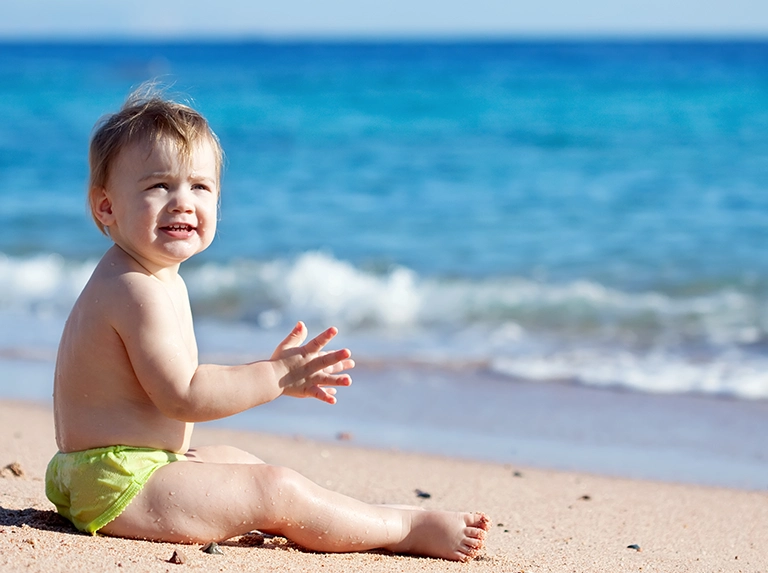
26
Mar
Sun Protection for Babies: Keeping Your Little One Safe in the Sun
Sunshine brings warmth, joy, and vitamin D, but for babies, it can also pose a significant risk. Their delicate skin is highly susceptible to sunburn, which can be not only uncomfortable but also have long-term health consequences. As parents, it’s our responsibility to ensure our little ones are protected from the sun’s harmful rays.
Why is Sun Protection Crucial for Babies?
Babies have thinner skin compared to adults, making them more vulnerable to sun damage. This delicate skin burns easily, leading to painful redness, discomfort, and even blistering. Sunburns in infancy can increase the risk of developing skin cancer later in life. Additionally, repeated sun exposure can contribute to premature aging of the skin.
The Importance of Sun Safety from a Young Age
Developing healthy sun safety habits early on is crucial for protecting your child throughout their life. Establishing these habits during infancy sets a strong foundation for sun-safe behavior as they grow older.
Essential Sun Protection Measures:
1. Protective Clothing for Infants:
The first line of defense against sun exposure is clothing. Opt for loose-fitting, breathable garments made from tightly woven fabrics with a high Ultraviolet Protection Factor (UPF) rating. Look for long-sleeved shirts, pants, and wide-brimmed hats that provide ample coverage.
2. Safe Sunscreens for Infants:
While sunscreen should be used as a last resort after seeking shade and covering up, it can be necessary for exposed areas like the face, hands, and feet. When choosing a baby sunscreen, remember:
SPF: Look for a broad-spectrum sunscreen with SPF 30 or higher.
Ingredients: Choose mineral-based sunscreens containing zinc oxide and titanium dioxide, which are generally gentler on baby skin. Avoid sunscreens with oxybenzone, octinoxate, and other potentially harmful chemicals.
Example: Consider Sebamed Sunlotion Baby Spf50 as an option. It boasts broad-spectrum protection with SPF 50+ and is formulated with zinc oxide and titanium dioxide, making it suitable for delicate baby skin.
Another notable option worth considering is the Cetaphil Kids Sun SPF 50 Lotion. Similar to Sebamed, it boasts a high SPF of 50, providing robust protection against the sun’s rays. Cetaphil, a trusted brand in skincare, formulates this sunscreen specifically for children.
3. Seeking Shade:
Whenever possible, seek shade for your baby. Utilize umbrellas, strollers with sunshades, or find natural shade under trees. Remember that shade intensity can vary, so be mindful of changing positions throughout the day.
Additional Sun Protection Tips:
Baby sunglasses: For older babies, consider sunglasses with UV protection to shield their eyes from the sun’s harmful rays. Choose sunglasses that fit snugly and block out UVA and UVB rays.
Sunscreen application for babies: Apply sunscreen generously and evenly to exposed skin 15 minutes before sun exposure. Reapply every two hours, or more often after swimming or sweating. Avoid applying sunscreen around the eyes and lips.
Infant sun protection essentials: Create a checklist of essential items to pack whenever you head outdoors with your baby, including sun-protective clothing, a hat, baby sunscreen, sunglasses, and shade options.
Conclusion:
Sun protection for babies is an essential part of keeping them safe and healthy. By incorporating these simple yet effective measures into your daily routine, you can ensure your little one enjoys the outdoors while minimizing the risks associated with sun exposure. Remember, consistency is key. Make sun safety a priority from the very beginning, and you’ll be setting your child on the path to a lifetime of healthy sun habits. Our website has wide range of mom and baby products shop now at Divaaglam.com
FAQs: Sun Protection for Babies
1. At what age can I use sunscreen on my baby?
Generally, avoid sunscreen on babies under 6 months. Their skin is very sensitive, and sunscreens can irritate it. If necessary for minimal exposed areas, consult your pediatrician for guidance on choosing a safe and gentle baby sunscreen.
2. How often should I reapply sunscreen on my baby?
Reapply sunscreen every two hours, or more often if your baby is sweating or swimming. Even water-resistant sunscreen needs reapplication after water exposure.
3. What are some signs of sunburn in babies?
Redness, swelling, pain, and fussiness are common signs. If you notice any, bring your baby indoors and seek medical advice if needed.
4. Can I take my baby swimming with sunscreen on?
Yes, but choose a water-resistant baby sunscreen and reapply more frequently after swimming or sweating. Remember, shade is still the best protection.
5. What sunscreen is recommended for babies?
Look for a broad-spectrum sunscreen with SPF 30 or higher. Sebamed Sunlotion Baby Spf50 is an example, but consult your pediatrician for personalized recommendations.












